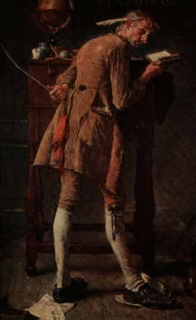
"The Devil and Tom Walker" and "The Legend of Sleepy Hollow" by Washington Irving.
The first story was published as part of his short story collection, "Tales of a Traveller" (1824). The narrator is Gentleman Geoffrey Crayon, and the story has been compared to Goethe's "Faust," which is about a scholar who made a deal with the devil. The Legend of Sleepy Hollow was part of his short stories titled "The Sketchbook" (1819).
Irving is often referred to as the Father of the American short story, because of his unique, light touch, note of humor and polished contributions to the form of the short story. His stories included defined characters in specific American towns or locations.
*painting by Norman Rockwell of Ichabod Crane
For a color-coded, thematic version of "The Legend of Sleepy Hollow" click here.
Washington Irving is often considered to be the first American writer of note. It is said by some lecturers that "The Legend of Sleepy Hollow" is a commentary on the "Old" America and the "New" America. Perhaps that means that the old America represents the Orthodox Christian Theistic view of the world (William Bradford, Cotton Mather, Anne Bradstreet, others) versus the "New" American Romanticism.
Characteristics of American Romanticism, as defined by the Oxford Companion to American Literature:
"Romanticism is a term that is associated with imagination and boundlessness, as contrasted with classicism, which is commonly associated with reason and restriction. A romantic attitude may be detected in literature of any period, but as an historical movement it arose in the 18th and 19th centuries, in reaction to more rational literary, philosophic, artistic, religious, and economic standards.... The most clearly defined romantic literary movement in the U. S. was Transcendentalism...."Characteristics of the romantic movement in American literature are sentimentalism, primitivism and the cult of the noble savage; political liberalism; the celebration of natural beauty and the simple life; introspection; the idealization of the common man, uncorrupted by civilization; interest in the picturesque past; interest in remote places; antiquarianism; individualism; morbid melancholy; and historical romance."
Other important points:
* Reaction against logic and reason; there was a generalized suspicion of Science and logic, though the zeal of this anti-science sentiment depended on the author or artist. Thoreau was a good and enthusiastic naturalist; Poe was perhaps the most phobic about science.
* Faith in something 'inherently good' and 'transcendent' in the human spirit, an inward divinity in no need of salvation, but in need of awakening.
* Faith was in the spirituality and the symbolic importance of nature
* Anglo-French celebration of common and rural life provided a model for American writers, who sought a way to satisfy a cultural need for lore - a mythology suitable to the new, American nation.
* As the "Fireside Poets" (Bryant, Whittier, Longfellow) became enormously popular in American households, they proclaimed a life of simple living, intuitive wisdom, innocent love, and community folklore. By 1870, Longfellow was out-selling every other 19th century author writing in English, including Wordsworth, Browning, Tennyson, and even Charles Dickens.
* In the arts, romanticism promoted a popular taste for wild landscapes, ominous skies, ancient ruins, picturesque rusticity, and other pastoral settings for thought-provoking inspiration.
No comments:
Post a Comment